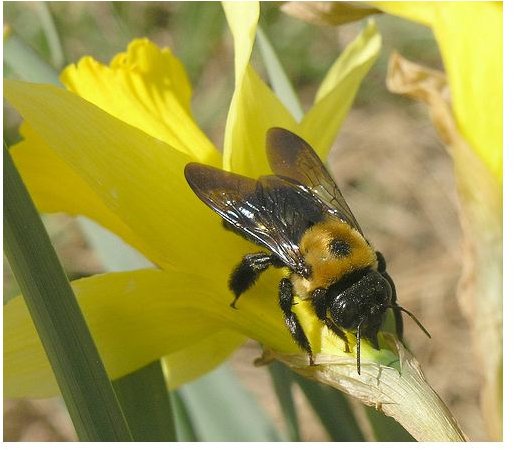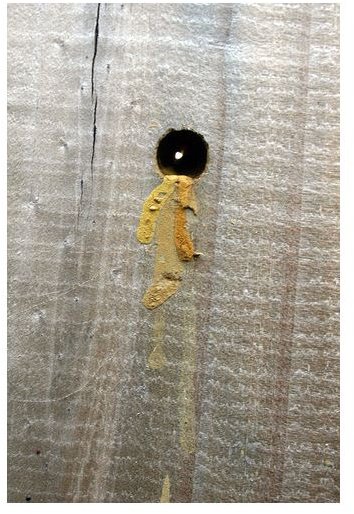Carpenter Bee Removal & Prevention
There are over 500 species of carpenter bee in the world so one of the major pest control problems is carpenter bee removal. Prevention of carpenter bee damage begins with determining if you actually have carpenter bees or another similar looking type. The major American variety is the Xylocopa Virginica and looks quite similar to the common bumble bee.
Is it a Carpenter Bee or Bumble Bee?
Carpenter bees are often mistaken for bumble bees, which leads to quite a bit of bad press for them. While bumble bees are prone to sting without provocation, carpenter bees only sting as a last resort and only the females do at that (males are not equipped with stingers). The males are territorial and may buzz you, but they can’t do anything to hurt you.
The major difference between the eastern carpenter bee and the bumble bee is that the carpenter bee only has yellow on its back where the bumble bee has yellow all the way around its body. Another major way to tell is that bumble bees nest in the ground while carpenters build homes in trees, wood siding, or other wood-based materials.
Bumble Bee or Carpenter Bee?

Carpenter Bee Damage
So you’ve determined that you do have a carpenter bee problem. The damage is going to depend on the length of time that carpenter bees have been in your home or structure. If the bees are new to the area, they will begin burrowing out a nest in the wooden parts of your home. These nests will extend inward about two inches and then abruptly make a 90 degree turn and extend up to two feet into the wood. Because they would rather reuse and extend older nests than build entirely new ones the nest systems cause a Swiss cheese effect on the wood, significantly decreasing the load bearing capacity. Wood replacement is necessary when the strength of structural members, posts, poles, and other wood products is reduced due to carpenter bee damage. This type of replacement can be quite costly depending on the area of the damage.
There are several places to look for the bee’s nests: house’s eaves, the underside of a pool deck, porch railings, window trim, wood siding, fence posts, fascia boards, outdoor furniture, wooden shakes, window frames or any other exposed wood. When the bees get into the attic area and start to infest the truss system, the roof may become unstable leading to sagging and potential leaks. The water damage caused by this type of structural compromise will only compound the cost of repairs. A simple roof repair will cost, at a minimum, $2500 for supplies and labor (and that’s if you are only dealing with a small section). These bees aren’t only responsible for direct damage but also the indirect damage of predatory birds (mostly woodpeckers) and fungus and mold growth in the bee tunnels.
Preventative Measures
If you’ve just begun to notice carpenter bees in and around your home you may have time to use preventative measures like topical insecticides such as carbaryl (Sevin), permethrin, or cyfluthrin. These chemical applications for carpenter bee control work by sitting on top of the wood an entering the bloodstream of the bee when it begins to burrow into the treated wood. These chemicals only last for a week at the most and will only work if they are near a started nest or area on which the bee lands. The insecticide is most effective in early spring just as the bees are emerging from their nests after overwintering.
If you are building in an area where carpenter bees are prevalent consider using aluminum, asbestos, asphalt, vinyl siding, or similar non-wood materials on the exterior of your building. Also caulk any gaps that may look inviting as potential nesting sites, especially uncapped screw or nail holes that act like starters for bee nests.
How Do I Get Rid of Carpenter Bees?

Getting rid of a carpenter bee infestation can be a tough job. These bees are not the social type so there is no chance of having workers bring poison back to a central colony. Carpenter bees need to be dealt with individually. There are several methods including carpenter bee traps, closing off or destroying nests, and introducing poison dust into each bee gallery.
Carpenter bee control begins with identifying every nest or potential nest in the building exterior. Carpenter bee nest entrances are holes are perfect circles about the size of a pencil eraser. The most likely places to find a nest are just below eaves, windowsills, and awnings but any protected area is a potential nesting point (if you have cedar shingling the lips beneath the shingles are a prime nesting area). Once you’ve found the nests you can begin with a carpenter bee elimination plan. Any work that you are planning to do around the nest should be done at night when it is cool and the bees are less likely to be active.
The most effective way to handle your bee problem is to seal off the entrance of each individual nest. Remember that these bees are not social and live alone, one bee per nest. Use silicone caulk to fill the holes as completely as possible. Although the reason is unknown, the bees will not try to dig their way out. They will remain trapped in their nests until they die. This is a time intensive activity but if you get all of the nests sealed then you will have no bees next year.
If you are concerned that blocking off the entrances will cause the bees to dig deeper into the woodwork and cause more damage you may try spraying them with insecticide. Any bee killer will work, and the bees are large enough that they are easy to hit in mid-flight. Killing off larvae in nests is a simple matter of straightening out a sturdy wire and thrusting it into the nest and scrambling the eggs.
Another option is injecting poison laced dust into the bee hole and letting the bee drag it back to the larvae. This dust can be applied with a duster (available at most hardware or home improvement stores) or a DIY solution can be fashioned with a turkey baster.
After carpenter bee removal, prevention is key to keep them from coming back. Remove all of the previously infested wood that has suffered structural damage and replace it with pressure-treated wood if possible (wolmanized lumber used to be the go-to material, but today regulations limit its use considerably). Make sure the wood is painted, not stained, as the latex paint is a deterrent. Keep up on the paint job to prevent flaking and exposure of the wood to potential infestation.
References
National Park Service CARPENTER BEE Xylocopa spp
The Connecticut Agricultural Experiment Station Carpenter Bees
Ohio State University Extension Fact Sheet Capenter Bees
NC State University Department of Entomology Insect Notes
Carpenter Bees Managment Guidelines UC IMP
How to Get Rid of Carpenter Bees
Wood Boring Carpenter Bees, damage to wood from bees, Hays Pest Control
Image of Carpenter Bee Hole courtesy of TobyOtter @ FlickR
Image of Eastern Carpenter Bee courtesy of Slomoz @ FlickR
Image of BumbleBee courtesy of dnhoshor @ FlickR
